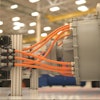Having used cleaning chemicals in our homes and offices for years, many people, including professionals in the cleaning industry, have somewhat of a nonchalant attitude toward them — considering these products relatively safe to use in almost all situations. Indeed, the actual risks associated with most consumer cleaning chemicals, if used properly and at typical exposure levels, are probably low.
However, professional cleaning chemicals, especially those used in industrial and manufacturing settings, can be potentially dangerous. In fact, data from Washington State University indicates that every year about six of every 100 custodians in the U.S. experience a job-related injury from cleaning chemical exposure. Of these injuries, 40 percent are eye related, 36 percent are skin irritations and burns, and 12 percent involve inhaling chemical fumes.
One reason for these injuries is that most professional cleaning chemicals are delivered to end users in concentrated form. This makes them very powerful right out of the bottle. Depending on the manufacturer’s labeling instructions, most of these chemicals need to be diluted with water by two parts to as much as 20 parts or more before they are safe to use.
Additionally, we know that some cleaning chemical ingredients — although they are effective — can be harmful if used improperly. Because of this, manufacturing facility managers are encouraged to work with their custodial crews as well as their jansan (janitorial supply) distributors to develop a cleaning chemical safety program to minimize if not eliminate potential injuries. This is not only for the safety of the cleaning crew but also for the safety of all building occupants.
A Cleaning Chemical Safety Program
Education and training are the most important components of a cleaning chemical safety program. A formal, documented program will ensure that everyone — building managers, supervisors, cleaning professionals, and building occupants — is aware of the precautions and procedures to prevent injuries.
Educating workers and others about chemical safety procedures is not a “one-time deal.” Studies indicate that the more often these procedures are discussed and presented, the more likely they will be incorporated into everyday cleaning practices.
Among the components of a good chemical safety program are:
• Documentation of all chemicals used to clean a facility, including how many gallons are stored, a short description of how they are to be used, the type of hazard they present, and where they are stored.
• Material safety data sheets (MSDS), as well as first-aid information, should be included with the documentation for each chemical product.
• Removal of chemicals that are inactive, especially products in storage for more than six months.
• Evaluation of all chemicals for safer, yet equally effective, cleaning alternatives.
• Minimal handling of cleaning chemicals by using auto-dilution/dispensing systems to mix chemicals.
• Keep cleaning chemicals in their original containers to ensure that the containers are clearly marked and labeled with the manufacturer’s instructions for use and safety.
• Have secondary labels on hand for chemicals used from concentrates to reduce the possibility of unlabeled bottles.
• Safe storage of cleaning chemicals away from direct sunlight, heat, and food items.
• Make sure unauthorized building occupants do not have access to chemicals.
• Store chemicals in well-ventilated areas, and store some chemicals separately from others, when required per manufacturers' instructions.
• Use safety posters or safety graphics without words and multilingual chemical-use instructions to overcome language barriers.
• Encourage maintenance personnel to seek medical advice if any irritation or allergic reaction to a cleaning chemical develops.
• Continue to monitor your chemical safety program and provide ongoing training.
What to Wear
A final step in chemical safety involves wearing protective equipment – or PPE (Personal Protective Equipment). Although most cleaning professionals wear gloves regardless of the cleaning task, whether it be cleaning restrooms or vacuuming, many still do not wear goggles.
Rubber gloves offer the best protection and gloves that have holes, tears, or patches should not be worn. Cleaning without proper protective clothing is inviting an accident to happen.
Michael Kauffman is Eastern Regional Manager for Pro-Link, a janitorial supply company based in Canton, MA.





















